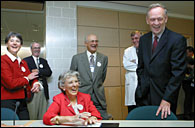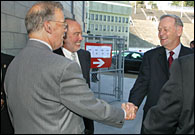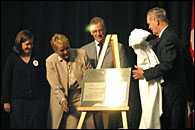Research centre opens
The official opening of the Brain Tumour Research Centre September 17 was a grand affair. Heather Hiscox, co-anchor CH News, Hamilton, emceed the opening ceremony. Prime Minister Jean Chrétien and Quebec Deputy Prime Minister Pauline Marois spoke to the crowd of over 500. Grade 6 Children's World Academy students sang brain awareness songs ("I've been working on my neurons"). The Montreal Neurological Institute's jazz ensemble jammed during lunch, and tours were given of the new three-storey, 24,000 square foot Centre's lab space.
 Left to right in the De Grandpré Communications Centre: Suzanne de Grandpré, Vice-Principal (Development and Alumni) Derek Drummond, Hélène de Grandpré, Jean de Grandpré, Dr. Rolando Del Maestro and Prime Minister Jean Chrétien.
Left to right in the De Grandpré Communications Centre: Suzanne de Grandpré, Vice-Principal (Development and Alumni) Derek Drummond, Hélène de Grandpré, Jean de Grandpré, Dr. Rolando Del Maestro and Prime Minister Jean Chrétien.PHOTO: Owen Egan |
|
The Centre received a $3.9-million grant from the Canada Foundation for Innovation, matched by the Fonds de recherche en santé du Québec. Private donors such as the Molson Foundation and the McConnell Family Foundation helped make up the rest of the $26-million budget for constructing and equipping the addition to the Montreal Neurological Institute.
It was the first day of use for the state-of-the-art telecommunications conference room, the de Grandpre Communications Centre. That day brought together McGill's top minds to discuss cancer research and brain tumours. At each seat are laptop plug-ins, and the room is wired for whiteboard notes to be downloaded onto your laptop. The room's videoconferencing and distance learning capabilities will allow for physicians and researchers around the world to collaborate in a cyberwink. They can transmit diagnostic images, present patients, and discuss diagnoses and treatments.
The bright and airy labs of the BTRC currently in use by Clinical Research Director of the Centre, Dr. Rolando Del Maestro, Dr. Peter McPherson and Dr. Christian Sirard. A microscopy room has a fluorescent microsope able to acquire data and analyze images digitally, and a multiphoton confocal microsope that uses infrared light to illuminate a cell bit by infinitesimal bit.
 Principal Bernard Shapiro, MNI Director David Colman and Prime Minister Jean Chrétien
Principal Bernard Shapiro, MNI Director David Colman and Prime Minister Jean ChrétienPHOTO: Owen Egan |
|
Brain tumours act swiftly and mysteriously. A tumour in the lung is most likely one of three types, whereas a tumour in the brain could be one of over a hundred different kinds. Forty percent of the time, they're benign, but the rest are malignant.
Many other kinds of tumours -- kidney, breast, lung -- occur first in a patient's body, but those can metastasize to the brain. Primary brain tumours, which develop first in the brain, can spread within the brain, but not elsewhere.
Del Maestro says, "Brain tumours really are an attack on the soul. They change the ability of the individual to interact with the environment, they change the individual's personality. They take away everything that person was.
"Brain tumours right now are taking the lives of more children than any other cancer; that is clearly a significant problem. They're common in young adults and they seem to be increasing in the older population."
Why do brain tumours affect children so frequently? One hypothesis, Del Maestro says, is that "somewhere at the age of one through five, there's a signal [to the cells] that goes out and says 'stop.' What happens is, unfortunately, not all cells behave the way they should, and they still grow."
There are many questions about brain tumours and few answers.
Del Maestro's primary concern is always the patient. "I developed the clinical skills to give, as best I can, information about surgical, radiation or chemotherapy options." He has organized patient support groups, including the Brain Tumour Foundation of Canada he set up with his wife, Pamela, and Steve Northey, who lost his daughter to a brain tumour.
One benefit of the BTRC is patient networks. "I have a brain tumour patient, and there's another patient I have who had almost exactly the same thing -- it's very important to get those people together. I can tell people what the risks are, I can tell people what it's going to be like, but I have not experienced it myself."
Del Maestro strives to "develop the skills to grapple with the questions of brain tumours, the science behind them.
"It's been a bit of a paradigm shift for me as a surgeon," Del Maestro says. Because the cells that cause brain tumours can be far from the site of the tumour, surgical removal doesn't guarantee elimination of the cancerous cells. During the scientific symposium, Del Maestro described an early procedure in which a doctor had removed the entire right hemisphere of a patient's brain in an attempt to beat the disease's spread -- the tumour still recurred on the other side. "Right at the start we're beaten."
Del Maestro likens the battle against brain tumours to the military. With surgery, you think you're bringing in the heavy artillery, but there's always guerrilla cells. You have to go after each individual cell.
 The unveiling of the plaque
The unveiling of the plaquePHOTO: Owen Egan |
|
Recent research has been geared towards the "go or grow" hypothesis in which it's believed that a cell either divides or moves, but can't do both at once. If a cell can be triggered into thinking it's dividing, then it will stop moving, and vice versa. Unfortunately, it's looking as though some cells are able to multitask a little too efficiently for the liking of cancer battlers.
Del Maestro's research is on the invasiveness of tumour cells and the methods to stop their spread. Clearly, the tumour must be tackled multiple ways -- there's not enough time to try consecutive treatments.
"We hope to extend lives, to turn an acute disease into a chronic disease, by controlling the cells," Del Maestro says. "When you have only 6 months, it's very difficult to mobilize your resources."
Centres like this one will accelerate the battle against brain tumours. Research procedures that took years to do before, such as the isolation and characterization of a protein, can now be done in one day. Del Maestro confidently says, "I've come to the conclusion that there's going to be an absolute explosion of information in the next two to five years, thanks to the molecular biology world."

